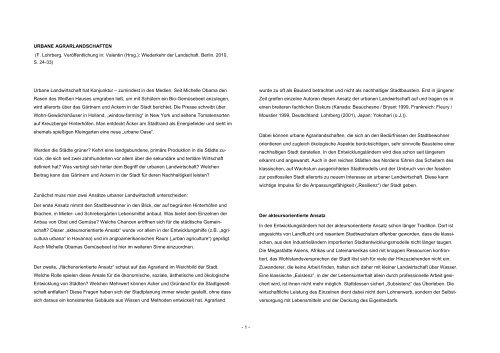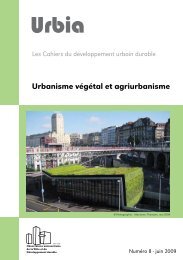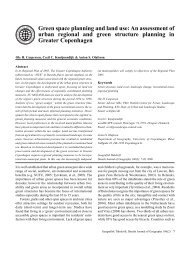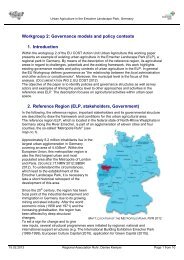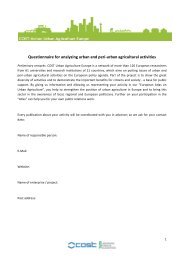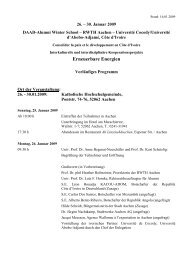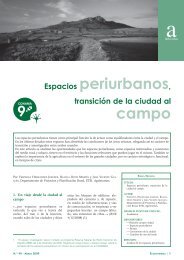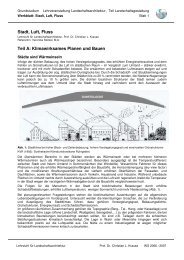- 1 - URBANE AGRARLANDSCHAFTEN (F. Lohrberg ...
- 1 - URBANE AGRARLANDSCHAFTEN (F. Lohrberg ...
- 1 - URBANE AGRARLANDSCHAFTEN (F. Lohrberg ...
Sie wollen auch ein ePaper? Erhöhen Sie die Reichweite Ihrer Titel.
YUMPU macht aus Druck-PDFs automatisch weboptimierte ePaper, die Google liebt.
<strong>URBANE</strong> <strong>AGRARLANDSCHAFTEN</strong><br />
(F. <strong>Lohrberg</strong>. Veröffentlichung in: Valentin (Hrsg.): Wiederkehr der Landschaft. Berlin. 2010,<br />
S. 24-33)<br />
Urbane Landwirtschaft hat Konjunktur – zumindest in den Medien. Seit Michelle Obama den<br />
Rasen des Weißen Hauses umgraben ließ, um mit Schülern ein Bio-Gemüsebeet anzulegen,<br />
wird allerorts über das Gärtnern und Ackern in der Stadt berichtet. Die Presse schreibt über<br />
Wohn-Gewächshäuser in Holland, „window-farming“ in New York und seltene Tomatensorten<br />
auf Kreuzberger Hinterhöfen. Man entdeckt Äcker am Stadtrand als Energiefelder und sieht im<br />
ehemals spießigen Kleingarten eine neue „urbane Oase“.<br />
Werden die Städte grüner? Kehrt eine landgebundene, primäre Produktion in die Städte zurück,<br />
die sich seit zwei Jahrhunderten vor allem über die sekundäre und tertiäre Wirtschaft<br />
definiert hat? Was verbirgt sich hinter dem Begriff der urbanen Landwirtschaft? Welchen<br />
Beitrag kann das Gärtnern und Ackern in der Stadt für deren Nachhaltigkeit leisten?<br />
wurde zu oft als Bauland betrachtet und nicht als nachhaltiger Stadtbaustein. Erst in jüngerer<br />
Zeit greifen einzelne Autoren diesen Ansatz der urbanen Landwirtschaft auf und tragen es in<br />
einen breiteren fachlichen Diskurs (Kanada: Beauchesne / Bryant 1999, Frankreich: Fleury /<br />
Moustier 1999, Deutschland: <strong>Lohrberg</strong> (2001), Japan: Yokohari (o.J.)).<br />
Dabei können urbane Agrarlandschaften, die sich an den Bedürfnissen der Stadtbewohner<br />
orientieren und zugleich ökologische Aspekte berücksichtigen, sehr sinnvolle Bausteine einer<br />
nachhaltigen Stadt darstellen. In den Entwicklungsländern wird dies schon seit längerem<br />
erkannt und angewandt. Auch in den reichen Städten des Nordens führen das Scheitern des<br />
klassischen, auf Wachstum ausgerichteten Stadtmodells und der Umbruch von der fossilen<br />
zur postfossilen Stadt allerorts zu neuem Interesse an urbaner Landwirtschaft. Diese kann<br />
wichtige Impulse für die Anpassungsfähigkeit („Resilienz“) der Stadt geben.<br />
Zunächst muss man zwei Ansätze urbaner Landwirtschaft unterscheiden:<br />
Der erste Ansatz nimmt den Stadtbewohner in den Blick, der auf begrünten Hinterhöfen und<br />
Brachen, in Mieter- und Schrebergärten Lebensmittel anbaut. Was bietet dem Einzelnen der<br />
Anbau von Obst und Gemüse? Welche Chancen eröffnen sich für die städtische Gemeinschaft?<br />
Dieser „akteursorientierte Ansatz“ wurde vor allem in der Entwicklungshilfe (z.B. „agricultura<br />
urbana“ in Havanna) und im angloamerikanischen Raum („urban agriculture“) geprägt.<br />
Auch Michelle Obamas Gemüsebeet ist hier im weiteren Sinne einzuordnen.<br />
Der zweite, „flächenorientierte Ansatz“ schaut auf das Agrarland im Weichbild der Stadt.<br />
Welche Rolle spielen diese Areale für die ökonomische, soziale, ästhetische und ökologische<br />
Entwicklung von Städten? Welchen Mehrwert können Acker und Grünland für die Stadtgesellschaft<br />
entfalten? Diese Fragen haben sich der Stadtplanung immer wieder gestellt, ohne dass<br />
sich daraus ein konsistentes Gebäude aus Wissen und Methoden entwickelt hat. Agrarland<br />
Der akteursorientierte Ansatz<br />
In den Entwicklungsländern hat der akteursorientierte Ansatz schon länger Tradition. Dort ist<br />
angesichts von Landflucht und rasantem Stadtwachstum offenbar geworden, dass die klassischen,<br />
aus den Industrieländern importierten Stadtentwicklungsmodelle nicht länger taugen.<br />
Die Megastädte Asiens, Afrikas und Lateinamerikas sind mit knappen Ressourcen konfrontiert,<br />
das Wohlstandsversprechen der Stadt löst sich für viele der Hinzuziehenden nicht ein.<br />
Zuwanderer, die keine Arbeit finden, halten sich daher mit kleiner Landwirtschaft über Wasser.<br />
Eine klassische „Existenz“, in der der Lebensunterhalt allein durch professionelle Arbeit gesichert<br />
wird, ist ihnen nicht mehr möglich. Stattdessen sichert „Subsistenz“ das Überleben. Die<br />
wirtschaftliche Leistung des Einzelnen dient dabei nicht dem Lohnerwerb, sondern der Selbstversorgung<br />
mit Lebensmitteln und der Deckung des Eigenbedarfs.<br />
- 1 -
Diese Landwirtschaft in der Stadt wurde von der Entwicklungshilfe zunächst als „Armutszeiger“<br />
bekämpft bis man merkte, welche Wohlfahrtswirkungen damit verbunden sind. Seit Mitte<br />
der 90er Jahre wirbt das United Nations Development Program, eine Entwicklungsorganisation<br />
der Vereinten Nationen, für urbane Landwirtschaft: „Agriculture has an important and beneficial<br />
place in the contemporary city.“ (UNDP 1996:8). Urbane Landwirtschaft ist nach Ansicht<br />
der UNDP hervorragend geeignet, die Nachhaltigkeit der Stadtentwicklung zu fördern. Sie wird<br />
sozialen und ökonomischen Ansprüchen gerecht, da sie Arbeitsplätze auch für niedrige Einkommensschichten<br />
bietet und dadurch Armut bekämpfen kann. Auch die Sozialstruktur der<br />
Gemeinden wird verbessert, Nachbarschaften werden gestärkt und das Selbstwertgefühl<br />
einzelner durch sinnvolle Tätigkeit erhöht.<br />
In den 90er Jahren hat die Sozialarbeit europäischer und amerikanischer Metropolen diesen<br />
akteursorientierten Ansatz übernommen. Im Blick standen und stehen seither Bevölkerungsgruppen,<br />
die durch Migration und Prekariat geprägt sind. In machen Quartieren haben sich<br />
diesbezüglich Strukturen entwickelt, die sich kaum von solchen in den Städten des Südens<br />
unterscheiden.<br />
So hat auch Michelle Obama mit ihrem Gemüsebeet am Weißen Haus auf Erfahrungen zurückgreifen<br />
können, die sie in den 90er Jahren in Chicago gesammelt hat, als sie den dortigen<br />
Bürgermeister in Fragen der Stadtentwicklung beriet. Chicago war eine der ersten Städte, die<br />
community gardens etablierte, also Nachbarschaftsgärten, in denen Bewohner Gemüse und<br />
Obst gemeinschaftlich anziehen konnten. Die community gardens sind seither Teil der städtischen<br />
Sozialarbeit. Sie sollen die lokalen Gemeinschaften stärken, das Miteinander fördern<br />
und Menschen ohne Arbeit eine Perspektive und Verantwortung geben. Einige gehen sogar<br />
so weit und propagieren die Gärten als Mittel gegen Vandalismus und Gewalt in den Quartieren.<br />
Michele Obama hat auf den pädagogischen Wert der Gärten hingewiesen: Kinder sollen<br />
über die Gartenarbeit lernen, wie wichtig gesunde Ernährung und Bewegung sind.<br />
Urbane Landwirtschaft als soziale Strategie<br />
Welchen Beitrag leistet der akteursorientierte Ansatz für eine nachhaltige Stadt? In den Städten<br />
des Südens stellt er – nicht zuletzt aufgrund der Vielzahl der Akteure – ein zukunftsweisendes<br />
Instrument der Stadtentwicklung dar, das es weiter zu stärken gilt. Landwirtschaft in<br />
der Stadt sollte nicht als Mangel und Armutszeiger betrachtet werden, sondern als legitimer<br />
Anspruch der Bevölkerung. Das Festhalten der Planung am Mythos der reichen Stadt verhindert<br />
die Entwicklung realistischer Strategien der Armutsbekämpfung.<br />
Dies gilt auch für die Städte der Industrieländer. Subsistenz ist hier bislang die Ausnahme. Die<br />
Versorgung mit Lebensmitteln und Energie scheint gesichert, erweist sich bei näherer Betrachtung<br />
jedoch als durchaus labil, da die langen und aufwändigen Transporte angesichts<br />
steigender Energiekosten und der CO2-Problematik nicht fortgeschrieben werden können. Die<br />
Zukunftsfähigkeit der Stadt hängt daher davon ab, ob gute Böden im Umland vor Bebauung<br />
geschützt werden können.<br />
Wo immer sich dann Versorgungslücken oder Risse in der staatlichen Wohlfahrt zeigen, kann<br />
die Landwirtschaft in der Stadt einen Beitrag zur Existenzsicherung leisten. Wir können das an<br />
osteuropäischen Städten beobachten, in denen viele Menschen nach dem Wegbrechen der<br />
Industriearbeit zur Subsistenzwirtschaft zurückgekehrt sind.<br />
Urbane Landwirtschaft sichert aber auch ein anderes Gut, nämlich Teilhabe am städtischen<br />
Leben, wie die community gardens zeigen, die ja vornehmlich in benachteiligten Quartieren<br />
entstanden sind. Diese Gärten machen deutlich, dass urbane Landwirtschaft nicht nur Kalorien<br />
produziert, sondern auch soziale Stabilität und Stadtkultur.<br />
- 2 -
Der flächenorientierte Ansatz<br />
Lösen wir unseren Blick vom community garden und vom Gemüsegarten am Weißen Haus,<br />
zoomen wir uns heraus aus den Hinterhöfen und Dachgärten und nehmen wir die Stadt in<br />
Gänze in den Blick, wie sie daliegt in der sie umgebenden Landschaft. Dort entdecken wir<br />
eine andere Form urbaner Landwirtschaft: Felder und Wiesen im Übergang von Wohn- und<br />
Gewerbegebieten zum ländlichen Umfeld, eingezwängt in die großen Versorgungslinien der<br />
Stadt wie Straßen, Schienen, Kanäle, zerschnitten und durchsetzt von Hochspannungsleitungen,<br />
Umspannwerken und Kläranlagen. Hier verdienen Bauern und Gärtner ihren Lebensunterhalt<br />
und beeinflussen über ihre Profession große Oberflächen des Stadtkörpers.<br />
Um die ökonomische und ökologische Nachhaltigkeit der Stadt zu stärken, müssen diese<br />
Agrarflächen in die Stadtplanung einbezogen werden. Schon Haber (1972:297) hat eine enge<br />
Verknüpfung „städtisch-industrieller“ Nutzungen mit „agrarischen Intensivflächen“ angeregt,<br />
um die „Stabilität“ des Naturhaushaltes im Ballungsraum zu erhalten.<br />
Urbane Landwirtschaft als nachhaltige Infrastruktur<br />
Dieses große Potential urbanen Agrarlandes wurde bislang weitgehend übersehen, sowohl<br />
von Seiten der Stadt als auch von Seiten der Landwirtschaft: In den Randzonen der wachsenden<br />
Stadt dienen Äcker und Grünland als Baulandreserven, die Spekulation verhindert langfristige<br />
Konzepte. Die Landwirtschaft selbst konzentriert sich in ihrem Selbstbild auf den ländlichen<br />
Raum mit dessen großen Produktionsvolumen. Das Bundesministerium für Ernährung,<br />
Landwirtschaft und Verbraucherschutz fasst „Landwirtschaft“ wie der Deutsche Bauernverband<br />
in eine Kategorie mit „Ländliche Räume“. Auch die Europäische Union, die ja zunehmend<br />
Agrarsubventionen in Strukturfördermittel umwidmet, übersieht die urbane Landwirtschaft<br />
und arbeitet ohne eine eigene Förderkulisse für urbane Landwirtschaft. Die EU vernachlässigt<br />
dabei, dass die eigentliche Kontaktzone zwischen der überwiegend in Städten<br />
lebenden EU-Bevölkerung und der Landwirtschaft am Stadtrand verläuft. Hier wird das Bild<br />
von der Landwirtschaft geprägt, hier besteht die große Chance zukunftsfähige Landwirtschaftsformen<br />
aufzubauen.<br />
Wie so etwas praktisch geht, hat bspw. Shanghai gezeigt, das noch in den 1990er Jahren<br />
nach Angabe der UNDP (1996:198) 90% seiner Abfälle zu Dünger verwandelt hat, der dann in<br />
der Region selbst verwendet wurde. Mit diesem Prinzip können Müll und Transportwege<br />
vermieden werden, die Verschmutzung von Böden und Gewässern reduziert sich. Mit Hilfe der<br />
Landwirtschaft wird ein stadtbezogenes Recycling aufgebaut, das Rohstoffbedarf und Abfallproduktion<br />
verringert.<br />
Fleury & Moustier (1999:281-288) sehen noch weitere Talente im Agrarland der Stadt und<br />
bezeichnen dieses als eine neue „Infrastruktur“ nachhaltiger Städte. Urbane Landwirtschaft<br />
ermöglicht demnach eine gesunde Ernährung, befördert die soziale Stabilität, unterhält kostengünstig<br />
die klimatisch und stadtstrukturell wichtigen Grünzüge und dient der Umweltbildung.<br />
Um diese Chancen zu nutzen, bedarf es mehrerer Paradigmenwechsel, wie an der Aufgabe<br />
der Gestaltung von Grünzügen durch Agrarland gezeigt werden kann. Grünzüge gliedern den<br />
Siedlungskörper. Sie verhindern ungesunde Bebauungsdichten und bringen frische, kühle Luft<br />
und Erholungsraum in die Stadt. In der Vergangenheit wurden diese Flächen oftmals von<br />
Acker in Parkanlagen oder Naturflächen umgewandelt. Was zunächst als Gewinn empfunden<br />
wurde, entpuppt sich zunehmend als Fehler: die großen Parkflächen können nicht angemessen<br />
gepflegt werden und Wildnis wird von der Bevölkerung nicht immer akzeptiert. Durch<br />
Landwirtschaft können die Grünzüge hingegen relativ kostengünstig unterhalten und zudem<br />
mit weiteren Angeboten aufgewertet werden (Direktvermarktung, Pferdesport, Blumen zum<br />
Selberpfücken, etc.). Man stellt also fest, dass die landwirtschaftliche Nutzung nicht ersetzt,<br />
sondern für die urbanen Ansprüche eingesetzt werden sollte.<br />
Das Management der Grünzüge durch Landwirtschaft erfordert auch ein Umdenken in ästhetischen<br />
Kategorien. Die Planung hat das städtische Agrarland lange Zeit vernachlässigt, weil<br />
moderne, industriell geprägte Anbaumethoden nur in geringem Maße den gängigen, ästhetischen<br />
Idealen von „heiler Landschaft“ oder „schöner Natur“ entsprechen.<br />
- 3 -
Macht man sich jedoch von diesen Idealen frei, dann kann man in den urbanen Fluren ein<br />
reiches gestalterisches Potenzial entdecken. So ist das Umfeld vieler europäischer Städte<br />
durch kleinteiligen Erwerbsgartenbau geprägt, der durchaus reizvolle und vitale Kulturlandschaften<br />
hervorgebracht hat, wie die Hamburger „Viermarschlande“ oder das Nürnberger<br />
„Knoblauchsland“ zeigen. Um diese Qualitäten zu wahren und zu entwickeln ist es wichtig, die<br />
urbane Landwirtschaft nicht als ländliches Relikt, sondern als städtisches Element zu verstehen<br />
und die besonderen Anpassungsprozesse der stadtnahen Landwirtschaft in den Mittelpunkt<br />
von Aufwertungsbemühungen zu stellen, insbesondere die jeweilige agrarische Eigenart,<br />
den Prozess der Spezialisierung und Diversifizierung und schließlich die zunehmende<br />
Dienstleistungsorientierung (<strong>Lohrberg</strong> 2000, 2001).<br />
Mehr und mehr Kommunen und Regionen greifen dieses konzeptionelle Verständnis urbaner<br />
Landwirtschaft auf. So hat der Emscher Landschaftspark sein Verhältnis zur Landwirtschaft<br />
neu dargelegt (Projekt Ruhr 2006) und setzt auf Kooperation und forcierte Anpassung statt auf<br />
Flächenentzug und Nutzungswechsel. Auch Städte wie Berlin, Köln oder Zürich suchen Wege<br />
in der Flächenentwicklung, bei der die Landwirtschaft nicht substituiert, sondern gezielt eingesetzt<br />
wird (z.B. Bauer / Hilker 2008). Im Kern geht es dabei um ein altes Thema der Gartenkunst,<br />
nämlich „das Schöne mit dem Nützlichen“ zu verbinden, so wie es Fürst Franz von<br />
Anhalt-Dessau schon vor über 200 Jahren für das Wörlitzer Gartenreich angestrebt hat. Der<br />
Fürst nutzte seinen Park auch, um „moderne“ Agrarmethoden zu erproben (u. a. Kleegrasanbau,<br />
Obstanbau, Seidenraupenzucht). Wörlitz gilt vielen daher als Beleg, dass Agrarland und<br />
Park einander befruchten und beide Teil einer gemeinsamen Idee von Landschaftsgestaltung<br />
sein können.<br />
Urbane Landwirtschaft und die Resilienz der Stadt<br />
Der akteurs- wie auch der flächenbezogene Ansatz impliziert deutliche Kritik an dem überkommenen<br />
auf Wachstum ausgerichteten westlichen Stadtmodell. Hermann (1999) hat in<br />
diesem Zusammenhang die Frage gestellt, was auf lange Sicht „normal“ ist: die Subsistenzwirtschaft<br />
und enge Verknüpfung von informeller Arbeit in Agrikultur und Stadt („informal<br />
city“) wie wir sie aus den Entwicklungsländern kennen oder eine an Modernität und Arbeitsteilung<br />
orientierte Stadt („formal city“). Ist letztere nicht eine Ausnahmesituation, die auf<br />
anhaltendem Wirtschaftswachstum und auf einem reichen Angebot fossiler Rohstoffe beruht,<br />
das so nicht fortgeschrieben werden kann?<br />
Es ist nicht absehbar, ob die Abkopplung individueller Lebens- und Wohnformen von der<br />
Nahrungsmittelerzeugung in den Industrieländern von Dauer sein wird. Schon heute ist aber<br />
auszumachen, dass die Städte sich in der post-Peak-Oil-Periode, in die wir eingetreten sind,<br />
nicht länger allein global versorgen können, sondern wieder verstärkt auf eigene Ressourcen<br />
zurückgreifen müssen. In diesem Zusammenhang wird auch der Stadtboden an Bedeutung für<br />
die verbrauchernahe Produktion von Nahrung und Energie gewinnen. Insofern werden neue<br />
Aufgaben auf die urbane Landwirtschaft zukommen, u.a wird das Paradigma der Extensivierung<br />
der Agrarnutzung in Frage gestellt werden. Zudem werden sich durch den Klimawandel<br />
die Rahmenbedingungen der Primärproduktion ändern.<br />
Angesichts dieser erwarteten, aber in ihren Ausmaßen und Wirkungen unbekannten Umbrüche<br />
ist eine hohe Aufmerksamkeit geboten. Städte müssen ihre Anpassungsfähigkeit und<br />
Widerstandskraft, ihre „Resilienz“ verbessern, um schnell und angemessen auf Veränderungen<br />
reagieren zu können. In diesem Sinne kann auch die urbane Landwirtschaft eingesetzt<br />
werden. Zum einen konkret: Schreitet die Informalisierung der Wirtschaft voran und steigt der<br />
Anteil prekärer Lebensverhältnisse, so sind die Bedingungen für Selbstversorgung und<br />
Selbstorganisation von Nachbarschaften durch die Bereitstellung von Flächen und professioneller<br />
Unterstützung zu stärken.<br />
Zum anderen aber auch in gedanklicher Hinsicht, indem die Auseinandersetzung mit der<br />
urbanen Landwirtschaft das Wechselspiel zwischen Stadtentwicklung und Verfügbarkeit von<br />
Ressourcen aufzeigt. Die Stadtplanung kann sich so freimachen von gängigen Denkschemata<br />
wachsender, funktionsteiliger Städte und sich neuen Formen von Stadt öffnen und mit diesen<br />
experimentieren.<br />
- 4 -
Produktion und Stadtbild<br />
Die urbane Landwirtschaft ist ein Mittel, um das Verhältnis des modernen Städters zur Arbeit<br />
zu entkrampfen. Der städtische Wohlstand basiert zwar auf Arbeit, doch spielt diese in der<br />
Stadtkultur nur eine untergeordnete Rolle. Kultur wird nach Feierabend gemacht, in den Straßen<br />
und Cafés, Museen und Opernsälen. Arbeit, Handarbeit zumal, versteckt sich hinter<br />
fensterlosen Fassaden oder Gewerbebauten. Hier wirkt nach, dass Generationen von Fabrikarbeitern<br />
am eigenen Leibe spürten, wie industrielle Arbeit Körper und Geist deformierte. Wer<br />
die Fabrikmauern hinter sich gelassen hatte, wollte keine Arbeit mehr sehen, weder im Haushalt<br />
noch in der Stadt. So sollten auch der Park und die Grünanlage ums Eck einfach nur<br />
schön sein, der Gärtner selbst wurde vom Schöpfer zum Störenfried des schönen Scheins.<br />
Die Stadtplanung nahm diese Wirkung industrieller Arbeit auf und trennte fortan Arbeiten und<br />
Erholen.<br />
Landwirtschaft hatte in der Stadt nichts zu suchen. Sie galt als Zeichen von Rückständigkeit,<br />
stand für das zurückgelassene, nicht immer überwundene Leben auf dem Land. Die labile<br />
urbane Identität wurde nicht zuletzt durch ornamentales Grün und die Abwesenheit agrarischen<br />
Handwerks gestärkt: Gemüsebeete wurden zu Rasenflächen, Getreidefelder am Stadtrand<br />
zu Parks.<br />
Der Preis der Identitätsfindung der modernen Stadt liegt in einer Entfremdung von Arbeit im<br />
Allgemeinen und primärer Produktion im Besonderen. Diese Entfremdung gilt es auf dem Weg<br />
zur nachhaltigen Stadt zu überwinden und dies auf unterschiedlichen Feldern.<br />
Auch ein vertiefter Blick in die Stadtgeschichte dürfte deutlich machen, wie eng Landwirtschaft<br />
und Stadt verbunden sind. Städte haben sich bis zur Industriellen Revolution nur dort entwickeln<br />
können, wo das Umland Überschüsse an Nahrung produzierte. Noch bis ins 18. Jahrhundert<br />
hinein funktionierten viele Städte als Ackerbürgerstädte. Die Bewohner bestellten das<br />
Land vor ihren Stadtmauern. Die Freiflächen in der Stadt wurden überwiegend zur Nahrungsmittelproduktion<br />
genutzt. Der Stadtwald diente der Bevorratung von Holz als Baustoff und<br />
Energielieferant. Auch die moderne Landwirtschaft ist am Stadtrand entstanden. Erst der<br />
Nährstoffüberschuss der Stadt erlaubte es den Landwirten, die arbeitsaufwendigen, Ackerbau<br />
und Viehzucht kombinierenden Wirtschaftsweisen zugunsten rentabler Spezialisierungen<br />
aufzugeben.<br />
Die Industrialisierung der Stadt hat mit dieser „Tandementwicklung“ radikal gebrochen, aber<br />
gleichzeitig auch neue Formen urbaner Landwirtschaft geschaffen wie die Gartenstadt- oder<br />
die Kleingartenbewegung zeigt. Stadtplaner haben dieses Gedankengut aufgenommen und<br />
ihre Modelle eingewoben. Es dürfte vielen unbekannt sein, dass Le Corbusier (1929) in seiner<br />
„ville contemporaine“ genauso Selbstversorgung vorsah wie Frank Lloyd Wright (1929), der im<br />
Jahr der Weltwirtschaftskrise sein Modell der „Broadacre City“ veröffentlichte. Auch darin ist<br />
der Farmer „höchstwillkommen“, sein Anwesen soll das „ [...] anziehendste unter all den Bauten<br />
der neuen freien Stadt der Zukunft sein [...].“<br />
Die Zurückschau auf die Stadt und ihre Planungsgeschichte stellt also einen enormen Wissensfundus<br />
dar, der für die Weiterentwicklung urbaner Landwirtschaft fruchtbar gemacht<br />
werden sollte.<br />
Hinschauen – Zurückschauen – Vorausschauen<br />
Eine gezielte Forschung sollte unser Bild von der urbanen Landwirtschaft schärfen. Seit die<br />
OECD in den 70er Jahren durch eine Reihe von Fallstudien die „periurbane Landwirtschaft“<br />
untersucht hat, hat es in den Industrieländern kaum systematische Analysen gegeben, schon<br />
gar nicht im internationalen Kontext. Wir wissen nur unzureichend, worüber wir reden. Ein<br />
„Atlas der urbanen Landwirtschaft“ könnte das Phänomen greifen, sichtbar machen und für die<br />
Planung aufbereiten.<br />
Nicht zuletzt sollte mit neuen Formen urbaner Landwirtschaft experimentiert werden, wozu<br />
auch der Anbau von Gehölzen gezählt werden sollte. Die heutige strikte Trennung zwischen<br />
Acker und Forst ist historisch betrachtet eine relativ neue Erscheinung. Bis ins 19. Jahrhundert<br />
führte die Ressourcenknappheit oftmals zu gemischten Anbauformen. In Hudewäldern wurden<br />
Schweine gemästet, auf Heiden und Allmendewiesen Brennholz geerntet. Die „Haubergswirt-<br />
- 5 -
schaft“ im Siegerland zeigte einen einzigartigen Produktionszyklus zwischen Eichenwald,<br />
Literatur<br />
Roggenacker, Viehweide und wieder Eichenwald.<br />
In der postfossilen Stadt erscheint eine Wiederbelebung solcher Mehrfachnutzungen angesichts<br />
zunehmender Ressourcenknappheit ratsam. So kann das Schnittgut aus der Pflege des<br />
Straßenbegleitgrüns als Brennstoff genutzt werden. Äcker am Stadtrand können als „Agroforstsysteme“<br />
neben Nahrungsmitteln auch dem Anbau von Wertholz dienen. Alte Industriebrachen<br />
können, so zeigt ein Beispiel aus Gelsenkirchen (BMVBS / BBSR 2009), durch die<br />
Anlage von Kurzumtriebsplantagen zu neuen produktiven Grünflächen werden. Die dortigen<br />
Initiatoren planen, den geschundenen Industrieboden durch den Anbau von Energieholz<br />
(Pappeln, Weiden) zu beleben. Durch Gestaltung und Angebote an die Bevölkerung soll die<br />
Holzplantage Qualitäten eines Parks bekommen.<br />
Diesen Ansätzen gemeinsam ist der Versuch die städtische Umwelt nicht einzelnen Sektoren<br />
einer funktionsgetrennten Stadt zu überlassen, sondern durch Mehrfachnutzungen zu kultivieren,<br />
wenn möglich als öffentliche, der Bevölkerung zugängliche Räume. Wo neuer Wald<br />
aufwächst, wird nicht nur CO2 gebunden, es wird auch eine Wertschöpfung in Gang gesetzt<br />
und es werden neue ästhetische und soziale Angebote entwickelt.<br />
Die Beispiele zeigen auch, dass sich die urbane Landwirtschaft nicht auf einen Reparaturbetrieb<br />
für die kriselnde Stadt beschränken muss. Sie sollte vielmehr als Baustein einer nachhaltigen<br />
Stadtentwicklung verstanden werden, die den Wohlstand breiter Massen zum Ziel hat.<br />
Die Stadtplanung darf sich auf diesem Weg nicht nur als verwaltendes Ordnungsinstrument<br />
verstehen, sondern muss Zukunft selber vorausschauend entwerfen und gestalten. Dazu<br />
gehören das Experiment und die Bereitschaft auch einmal zu scheitern. Nur so erlangt die<br />
Stadtgesellschaft das nötige Handlungswissen und ausreichende Flexibilität, um auf die kommenden,<br />
aber nicht vorhersagbaren Veränderungen angemessen reagieren zu können. Die<br />
urbane Landwirtschaft kann dazu einen wichtigen Beitrag leisten.<br />
Bauer, Joachim / Hilker, Thomas (2008): Landschaftspark Belvedere. Eine Weiterentwicklung<br />
des Kölner Grünsystems. Stadt und Grün. Heft 4, S. 17-20<br />
Beauchesne, Audric / Bryant, Christopher (1999): Agriculture and innovation in the urban<br />
fringe: the case of organic farming in Quebec, Canada. Tijdschrift voor economische en<br />
sociale geografie. Band 90, Heft 3, S. 320-328<br />
BMVBS / BBSR (Hrsg.) (2009): Renaturierung als Strategie nachhaltiger Stadtentwicklung.<br />
Dokumentation von Fallstudien. Werkstatt: Praxis Heft 62, S. 104 - 107<br />
Fleury, Andre / Moustier, Paule (1999): L’agriculture périurbaine, infrastructure de la ville<br />
durable. Chiers Agricultures. Heft 8, S. 281-287<br />
Haber, Wolfgang (1972): Grundzüge einer ökologischen Theorie der Landnutzung. Innere<br />
Kolonisation. Band 21, S. 294-298<br />
Hermann, Hans Joachim (1999): Planning for survival spaces in the city. Gate. Heft 2, S. 10-<br />
13<br />
Le Corbusier (1929): Städtebau. In einer Übersetzung von Hans Hildebrandt. Berlin, Leipzig<br />
<strong>Lohrberg</strong>, Frank (2000): Urbane Landwirtschaft als Erlebnisraum. Garten und Landschaft. Heft<br />
3, S. 9-12<br />
<strong>Lohrberg</strong>, Frank (2001): Stadtnahe Landwirtschaft in der Stadt- und Freiraumplanung. Stuttgart<br />
OECD (1978) - Organisation für Wirtschaftliche Zusammenarbeit und Entwicklung (Hg.): Die<br />
Landwirtschaft in Planung und Management peri-urbaner Gebiete. Band 2: Länderstudien<br />
Dänemark, Deutschland, Frankreich, Griechenland, Großbritannien, Österreich und Vereinigte<br />
Staaten<br />
Projekt Ruhr (2006): Masterplan Emscher Landschaftspark 2010. Essen<br />
UNDP (1996) - United Nations Development Programme: Urban Agriculture. Food, Jobs and<br />
Sustainable Cities. Publication Series for Habitat II. Volume 1. New York<br />
Wright, Frank Lloyd (1929): Usonien. When Democracy Builds. Deutsche Übersetzung von<br />
Georg Jäger und Georg Kamitsch. Berlin 1995<br />
Yokohari, Makoto (o. J.): Agro-activities in the Fringe of Asian Mega-Cities.<br />
http://www.nef.nenv.k.u-tokyo.ac.jp/articles/Yokohari.pdf, 6.8.2009<br />
- 6 -
Urban Agricultural Landscapes<br />
(F. <strong>Lohrberg</strong>. published in: Valentin (Hg.): Wiederkehr der Landschaft. Berlin. 2010, S. 24-33)<br />
Urban agriculture is thriving – at least in the media. Ever since Michelle Obama had the lawn<br />
at the White House dug up in order to plant an organic vegetable garden, farming and gardening<br />
in cities has been reported on everywhere. The press often reports on residential greenhouses<br />
in Holland, window farming in New York, and rare Tomato varieties in Kreuzberg<br />
backyards. People are rediscovering farmland on the urban periphery as energy production<br />
fields and finding new “urban oases” in what used to be considered bourgeois allotment gardens.<br />
Are cities getting greener? Is rural-based primary production returning to urban areas that<br />
have essentially defined themselves as secondary and tertiary economies for the past two<br />
hundred years? What lies behind the concept of urban agriculture? What contribution can<br />
gardening and farming in urban areas make to the overall sustainability of cities?<br />
First of all, it is important to differentiate between two kinds of urban agriculture:<br />
The first approach focuses on urban dwellers who cultivate food in backyards, empty lots, and<br />
allotment gardens. What does the planting of fruit and vegetables actually have to offer urban<br />
residents? What opportunities does this open up for urban communities? This “stakeholderoriented<br />
approach” is especially common in development aid (for example agricultura urbana<br />
in Havana) and in Anglo-American regions (urban agriculture). Michelle Obama’s vegetable<br />
garden can, in the broader sense, be put in this category. The second “area-oriented approach”<br />
involves agricultural land within the municipal area of a city. What role do these areas<br />
have for the economic, social, and aesthetic and ecological development of cities? What value<br />
can farmland and pastures add to urban society? Urban planners are continuously confronted<br />
with this question, but to date it has not lead to a consistent accumulation of knowledge or<br />
methods. Agricultural land is often merely seen as land that has not yet been built upon instead<br />
of a long-term urban component. Recently, however, individual authors have seized<br />
upon the idea of urban agriculture and have begun to introduce it to a broader discourse. i<br />
Urban agricultural landscapes that are oriented to the needs of urban residents and that also<br />
take ecological aspects into consideration represent extremely prudent elements of a sustainable<br />
city. This has been recognized and taken advantage of for a long time in developing<br />
countries. In wealthy cities in the northern hemisphere the foundering of the classical growthoriented<br />
urban model and the change from fossil fuels to post-fossil fuels has lead to fresh<br />
interest in urban agriculture. This could be an important impetus for the adaptability (“resilience”)<br />
of cities.<br />
The Stakeholder-oriented Approach<br />
The stakeholder-oriented approach has had a long tradition in developing countries. In view of<br />
rural flight and the rapid growth of cities, it has become obvious that the classical models of<br />
urban development imported from industrial countries no longer function. The megacities of<br />
Asia, Africa, and Latin America are faced with a shortage of resources, and the promise of<br />
wealth in these cities has not been fulfilled for many of the people moving into them. Immigrants<br />
who find no work often manage to stay afloat with small-scale agriculture. A classical<br />
“existence” where livelihoods are maintained through professional work is no longer possible<br />
for them. They manage to survive by “subsisting” instead. Individual economic performance<br />
does not involve the earning of wages, but instead the finding of enough food to eat and the<br />
covering one’s own needs.<br />
Until they recognized the favorable effects associated with this kind of agriculture in the city,<br />
those involved with development aid initially opposed it as being an indication of poverty. The<br />
United Nations Development Program (UNDP) has been promoting urban agriculture since the<br />
mid-nineteen-nineties: “Agriculture has an important and beneficial place in the contemporary<br />
city.” ii According to the UNDP, urban agriculture is particularly well-suited to promote the<br />
sustainability of urban development. It meets social and economic requirements as it provides<br />
jobs for lower-income groups, thus helping to fight poverty. The social structure of communities<br />
is also improved, neighborhoods are strengthened, and the self-esteem of individuals is<br />
increased as a result of a meaningful activity.<br />
In the nineteen-nineties social work in European and American cities adopted this stakeholderoriented<br />
approach. The focus has always been on groups of people who are characterized by<br />
migration and precarity. In this regard, some neighborhoods have developed to the extent that<br />
they differ little from cities in the southern hemisphere. With her vegetable garden at the White<br />
House Michelle Obama was able to draw on experience she had gained in Chicago in the<br />
nineteen-nineties, when she advised the city’s mayor about questions of urban development.<br />
Chicago was one of the first cities to establish community gardens in which residents could<br />
- 1 -
work together to plant vegetables and fruit. The community gardens have been a part of urban<br />
social work since then. They are intended to strengthen local communities, promote cooperation,<br />
and give unemployed people a perspective and a feeling of responsibility. Some go as far<br />
as promoting gardens as a means of preventing vandalism and violence in neighborhoods.<br />
Michelle Obama has pointed to the educational value of the gardens: By working in them,<br />
children should learn how important healthy nutrition and exercise are.<br />
Urban Agriculture as a Social Strategy<br />
What contribution does the stakeholder-oriented approach make to the development of sustainable<br />
cities? In southern cities it provides a forward-looking urban development tool–if for<br />
nothing else because of the large number of stakeholders–and should be further strengthened.<br />
Agriculture in cities should not be considered a shortcoming or a sign of poverty, but<br />
rather as a legitimate right of citizens. Holding fast to planning based on the myth of wealthy<br />
cities merely hinders the development of realistic strategies for fighting poverty.<br />
The same applies for cities in industrialized countries. Subsistence has been the exception up<br />
to now. At first glance the provision of food and energy appears to be secure. A closer look,<br />
however, reveals a situation that is quite precarious due to the fact that long and costly transport<br />
cannot be continued because of increasing energy costs and the problem of CO 2 production.<br />
The future viability of cities therefore depends on the ability to prevent good adjacent land<br />
from being built on. Urban agriculture can contribute to the securing of a city’s livelihood wherever<br />
an insufficient supply or defects within the welfare system occur. This can be observed in<br />
Eastern European cities, where many people reverted to living in subsistence economies after<br />
industrial work disappeared.<br />
Urban agriculture safeguards another asset as well, namely the participation in urban life, as<br />
illustrated by the community gardens, which were primarily created in poorer neighborhoods.<br />
These gardens make it clear that urban agriculture not only produces calories, but social<br />
stability and urban culture as well.<br />
The Area-oriented Approach<br />
Let’s look beyond the community gardens and the vegetable garden at the White House,<br />
zoom out of the backyards and roof gardens and take a look at the city as a whole, embedded<br />
in the surrounding landscape. Here we discover another form of urban agriculture: fields and<br />
pastures in transition from residential and commercial areas to a rural environment, wedged in<br />
between the city’s giant supply lines, i.e. roads, rail lines, and canals, and cut up and interfused<br />
by power lines, transformer stations, and water treatment plants. Farmers and gardeners<br />
earn their livings here and through their professions have an influence on large areas of<br />
the city structure.<br />
In order to strengthen the sustainability of cities, these agrarian areas have to be integrated<br />
into urban planning concepts. Even Wolfgang Haber suggested a close link be made between<br />
urban-industrial uses and intensively used agricultural areas in order to preserve the “stability”<br />
of the ecosystem in conurbations. iii<br />
Shanghai has shown how this can be done. According to the UNDP iv , as early as the nineteen-nineties<br />
the city converted ninety percent of its waste into fertilizer and then used it within<br />
the surrounding region. Using this principle, the transport of waste and supplies can be<br />
avoided and soil and water pollution reduced. With the aid of agriculture, a city-related form of<br />
recycling can be developed that reduces both the demand for raw materials and the production<br />
of waste.<br />
Andre Fleury and Paule Moustier v see additional prospects for metropolitan agricultural land<br />
and describe it as a new “infrastructure” for sustainable cities. In their opinion, urban agriculture<br />
promotes healthy nutrition and social stability, helps to maintain green corridors important<br />
to a city’s environment and structure in a cost-effective way, and encourages environmental<br />
education.<br />
Urban Agriculture as Sustainable Infrastructure<br />
Urban agricultural land’s great potential has been largely overlooked to date, by both those<br />
involved with cities as well as with agriculture. In the peripheral zones surrounding growing<br />
cities, farm fields and open space serves as a reserve of land for building upon, and speculation<br />
obstructs the development of long-term concepts. In its own self-image, agriculture focuses<br />
on rural areas with their potential for large-scale production. The German Federal Minis-<br />
- 2 -
try of Food, Agriculture and Consumer Protection and the German Association of Farmers<br />
both conceive “agriculture” as being in the same category as “rural areas.” As agricultural<br />
subsidies are increasingly redirected into structural funds, the European Union has also given<br />
little thought to urban agriculture, and has developed no grant programs in support of it. In<br />
doing so the EU is neglecting the fact that the contact zone between the majority of people<br />
who live in cities and agriculture on the outskirts is being lost. These areas are where the<br />
image of agriculture is actually shaped, and this is where the biggest opportunity to develop<br />
sustainable forms of agriculture exists.<br />
In order to take advantage of this opportunity several paradigm shifts are necessary, as can<br />
be illustrated in the substitution of agricultural land for designed green corridors. Green corridors<br />
are vegetated ribbons used to divide and structure developed areas. They prevent detrimental<br />
building densities and provide cities with fresh, cool air and recreational space. In the<br />
past agricultural areas were often transformed into parks or natural areas. What at first appeared<br />
to be a benefit increasingly proved to be a mistake: large parks cannot be properly<br />
maintained and residents do not always accept wilderness. Using these corridors for agriculture<br />
would allow for them to be economically maintained and they could be further enhanced<br />
through additional offers (direct marketing, horseback riding, pick your own flowers, etc.).<br />
Thus, agriculture should not be replaced but instead used to fulfill urban needs.<br />
The management of green corridors via agriculture also requires a change of thinking regarding<br />
aesthetic categories. Planning has long neglected urban agriculture because modern<br />
industrial methods of cultivation have little to do with today’s popular ideals of an ideal landscape<br />
or unspoiled nature. If people manage to free themselves of these ideals, however, they<br />
will discover a wealth of design potential in urban open space. The areas surrounding many<br />
European cities are characterized by small-scale horticulture that has unquestionably led to<br />
the development of attractive and vital cultural landscapes, for example the “Viermarschlande”<br />
near Hamburg or the “Knoblauchsland” near Nuremburg. In order to preserve and further<br />
develop these qualities it is important to recognize urban agriculture as an urban element and<br />
not as a rural relic. Special measures for adapting urban agriculture, i.e., the respective agrarian<br />
character, the process of specialization and diversification, or the increasing service orientation,<br />
must be at the center of any improvement efforts. vi<br />
More and more communities and regions are adopting this conceptual understanding of urban<br />
agriculture. Emscher Landscape Park, for instance, has reformulated its relationship with<br />
agriculture, and put an emphasis on cooperation and accelerated adaptation instead of reducing<br />
the size of the area or changing the type of land use. vii Cities such as Berlin, Cologne, and<br />
Zurich are also looking for methods of site development that do not replace agriculture but<br />
instead focus on its use. viii At its core this involves an old element of garden design, namely to<br />
“combine the beautiful with the utilitarian” as illustrated by Prince Franz of Anhalt-Dessau’s<br />
aspirations at the Garden Kingdom of Dessau-Wörlitz over two hundred years ago. The prince<br />
also used his park to test “modern” agricultural methods (including the cultivation of a clovergrass<br />
mixture, fruit growing, and silkworm breeding). For many, Wörlitz is therefore proof that<br />
agricultural land and parks cross-fertilize one another and that both can be part of a common<br />
idea of landscape design.<br />
Urban Agriculture and the Resilience of Cities<br />
Both the stakeholder-oriented approach and the area-oriented approach imply sharp criticism<br />
of the traditional growth-based western model of cities. In this context, Hans Joachim<br />
Hermann ix asked the question of what “normal” is in the long term: a subsistence-based economy<br />
and a close link between informal work in agriculture and the city (the informal city), which<br />
is similar to the one we know in developing countries, or a city oriented to modernity and the<br />
division of labor (the formal city)? Isn’t the latter an exceptional situation based on continuous<br />
economic growth and a large supply of fossil fuels, i.e. a model that cannot be perpetuated?<br />
It is not possible to predict whether the decoupling of individual forms of living from the production<br />
of food in industrial countries will be sustainable. It is already clear, however, that cities<br />
can longer rely on a global supply of provisions in the post-peak oil period that we have now<br />
entered, but instead must increasingly fall back on their own resources. In this context, urban<br />
land will become increasingly important for the production of food and energy for local consumers.<br />
Thus, new tasks will arise for urban agriculture and, among other things, the paradigm<br />
of the extensification of agriculture will be questioned. In addition, due to climate change<br />
the basic conditions of primary production will also change.<br />
These expected upheavals, the extent and effects of which are unknown, require us to be<br />
especially vigilant. Cities need to improve upon their adaptability and their resistance, i.e. their<br />
“resilience,” so that they are able to react quickly and appropriately to the coming changes. To<br />
this end, urban agriculture can also be taken advantage of. First of all, as the informalization of<br />
the economy proceeds and precarious living conditions increase, conditions for the self-<br />
- 3 -
sufficiency and self-organization of neighborhoods through the allocation of land and professional<br />
assistance should be strengthened. And secondly, there is a theoretical aspect as well,<br />
as the debate about urban agriculture reveals the correlation between urban development and<br />
the availability of resources. Urban planning can thus free itself of entrenched ways of thinking<br />
about growing and functioning cities and open themselves up to new urban forms that can be<br />
experimented with.<br />
Production and the Urban Image<br />
Urban agriculture is a means of loosening up the relationship modern urbanites have concerning<br />
work. Urban prosperity is based on work, and yet in urban culture this always plays but a<br />
subordinate roll. Culture occurs after the working day has ended, in the streets and cafes,<br />
museums and opera houses. Work, particularly that done by hand, is hidden behind windowless<br />
façades and in commercial buildings. This is the after-effect of generations of factory<br />
workers who experienced first-hand how industrial labor deformed both body and spirit. Those<br />
who managed to leave the factory behind wanted nothing more to do with work, whether it be<br />
in the household or in the city. The public park or green around the corner was simply supposed<br />
to be beautiful, and gardeners went from being creators of beauty to disruptive elements.<br />
Urban planners acknowledged this effect of industrial work and hereafter separated<br />
work from recreation.<br />
There was no place in the city for agriculture. It was considered a sign of backwardness, and<br />
represented a life in the country that had been left behind, if not always overcome. The unstable<br />
urban identity was strengthened by ornamental greenery and the absence of agricultural<br />
elements: vegetable gardens were turned into lawns and fields of grain on the periphery into<br />
parks.<br />
The cost of the modern city’s identity is an alienation from work in general and from primary<br />
production in particular. In creating the sustainable city, this alienation has to be overcome in a<br />
variety of ways.<br />
Looking Closely–Looking Back–Looking Forward<br />
Targeted research should be undertaken in order to sharpen our image of urban agriculture.<br />
Hardly any systematic analyses have been undertaken in industrial countries and none at all in<br />
the international context since the OECD x investigated a series of case studies involving “periurban<br />
agriculture” in the nineteen-seventies. We do not have sufficient knowledge of the subject<br />
we are talking about. An “Atlas of Urban Agriculture” could explore the phenomenon,<br />
make it more visible, and help prepare any planning efforts.<br />
A closer look at the history of cities should make it clear just how closely linked agriculture and<br />
cities are. Until the industrial revolution cities were only able to develop in locations where the<br />
surrounding area produced a surplus of food. Until well into the eighteenth century many cities<br />
and towns functioned only as farming communities. Open space in cities was mainly used for<br />
food production. Municipal forests served as sources of building materials and energy. Modern<br />
agriculture also began on the edge of cities. Not until cities had a surplus of food were farmers<br />
allowed to give up the labor-intensive cultivation of fields and raising of livestock in favor of<br />
more profitable specialized methods of farming.<br />
The industrialization of the city was a radical departure from this type of “tandem development,”<br />
but simultaneously created new forms of urban agriculture, as illustrated by the garden<br />
city and allotment garden movements. Urban planners adopted this mindset and incorporated<br />
it in their models. For many it may come as a surprise that Le Corbusier xi provided the same<br />
degree of self-sufficiency in his Ville Contemporaine that Frank Lloyd Wright xii did in his model<br />
of Broadacre City, which was presented during the great depression. The farmer was to be<br />
“extremely welcome,” his premises should be “[...] the most attractive of all the buildings in this<br />
new and free city of the future [...].”<br />
Looking back at the city and how it was planned reveals an enormous body of knowledge that<br />
should be taken advantage of in the continued development of urban agriculture. New forms of<br />
urban agriculture should be experimented with, including the planting of trees. From a historical<br />
perspective, today’s strict separation of field crops and forests is a relatively new practice.<br />
Until the nineteenth century a shortage of resources often led to mixed forms of cultivation. In<br />
“wood pastures” pigs were fattened, on heathlands and common pastures firewood was harvested.<br />
The Haubergswirtschaft, a common woodland management system used in the<br />
Siegerland region of Germany involves a unique production cycle beginning and ending with<br />
oak forests, which alternate with rye fields and grazing pastures. A reactivation of these kinds<br />
- 4 -
of multiple-use activities in post-fossil fuel cities would appear to be wise in light of a scarcity<br />
of resources. Cuttings gathered as a result of the maintenance of roadside trees and shrubs<br />
could be used as fuel. Farm fields on the edge of cities can be used in agroforestry systems to<br />
produce both food and timber. Old industrial areas can be turned into productive green areas<br />
through the planting of short rotational plantations, as has been done in Gelsenkirchen. xiii The<br />
initiators of this concept plan to regenerate the maltreated industrial soils by planting wood fuel<br />
plantations (poplars and willows). Through good design and activities for citizens such plantations<br />
should take on the character of a park. What these methods have in common is their<br />
attempt to rid the urban environment of individual sectors of a city that only have separate<br />
functions, and to cultivate multiple-use open space that, when possible, is accessible to the<br />
public.<br />
Not only will more CO 2 be bound where new forests grow, but added value will be created and<br />
new aesthetic and social activities developed. Examples show that urban agriculture does not<br />
have to confine itself to being a repair workshop for cities that are heading toward various<br />
crises. On the contrary, it should be viewed as a building block of sustainable urban development<br />
that aims to create prosperity for the general population. As this process unfolds, urban<br />
planners should not think of themselves as merely being administrators or enforcers, but must<br />
instead look ahead as they design and create the future. A willingness to experiment and<br />
make mistakes is part of this process. This is the only way urban society will acquire the necessary<br />
practical knowledge and flexibility to properly deal with upcoming changes, which are<br />
often unpredictable. Urban agriculture can make an important contribution to this.<br />
i Kanada: Beauchesne, Audric/Bryant, Christopher: „Agriculture and Innovation in the<br />
Urban Fringe: The Case of Organic Farming in Quebec, Canada“. In: Tijdschrift voor<br />
economische en sociale geografie. Band 90, Heft 3, 1999, S. 320–328<br />
Frankreich: Fleury, Andre/Moustier, Paule: „L’agriculture périurbaine, infrastructure de la<br />
ville durable“. In: Chiers Agricultures. Heft 8, 1999, S. 281–287<br />
Deutschland: <strong>Lohrberg</strong>, Frank: Stadtnahe Landwirtschaft in der Stadt- und Freiraumplanung.<br />
Stuttgart 2001<br />
Japan: Yokohari, Makoto: Agro-activities in the Fringe of Asian Mega-Cities.<br />
http://www.nef.nenv.k.u-tokyo.ac.jp/articles/Yokohari.pdf, asp, 6.8.2009<br />
ii UNDP – United Nations Development Programme: „Urban Agriculture. Food, Jobs and<br />
Sustainable Cities“. In: Publication Series for Habitat II. Volume 1. New York 1996, S.8<br />
iii Haber, Wolfgang: „Grundzüge einer ökologischen Theorie der Landnutzung“. In: Innere<br />
Kolonisation. Band 21, 1972, S. 294–298, hier S. 297<br />
iv UNDP – United Nations Development Programme: „Urban Agriculture. Food, Jobs and<br />
Sustainable Cities“. In: Publication Series for Habitat II. Volume 1. New York 1996, S. 198<br />
v Fleury, Andre/Moustier, Paule: „L’agriculture périurbaine, infrastructure de la ville durable“.<br />
In: Chiers Agricultures. Heft 8, 1999, S.281–288<br />
vi <strong>Lohrberg</strong>, Frank: „Urbane Landwirtschaft als Erlebnisraum“. In: Garten und Landschaft.<br />
Heft 3, 2000, S. 9–12<br />
und <strong>Lohrberg</strong>, Frank: Stadtnahe Landwirtschaft in der Stadt- und Freiraumplanung. Stuttgart<br />
2001<br />
vii Projekt Ruhr: Masterplan Emscher Landschaftspark 2010. Essen 2006<br />
viii Vgl. Bauer, Joachim/Hilker, Thomas: „Landschaftspark Belvedere. Eine Weiterentwicklung<br />
des Kölner Grünsystems“. In: Stadt und Grün. Heft 4, 2008, S. 17–20<br />
ix Hermann, Hans Joachim: „Planning for survival spaces in the city“. In: Gate. Heft 2,<br />
1999, S. 10–13<br />
x OECD – Organisation für Wirtschaftliche Zusammenarbeit und Entwicklung (Hg.): Die<br />
Landwirtschaft in Planung und Management peri-urbaner Gebiete. Band 2: Länderstudien<br />
Dänemark, Deutschland, Frankreich, Griechenland, Großbritannien, Österreich und Vereinigte<br />
Staaten, 1978<br />
xi Le Corbusier: Städtebau. In einer Übersetzung von Hans Hildebrandt. Berlin, Leipzig<br />
1929<br />
xii Wright, Frank Lloyd (1929): Usonien. When Democracy Builds. Deutsche Übersetzung<br />
von Georg Jäger und Georg Kamitsch. Berlin 1995<br />
xiii BMVBS / BBSR (Hg.): „Renaturierung als Strategie nachhaltiger Stadtentwicklung.<br />
Dokumentation von Fallstudien“. In: Werkstatt: Praxis Heft 62, 2009, S. 104–107<br />
- 5 -


